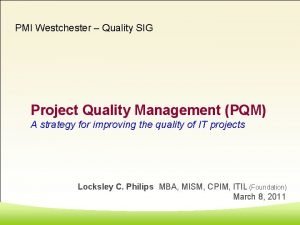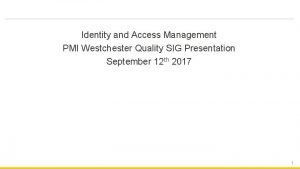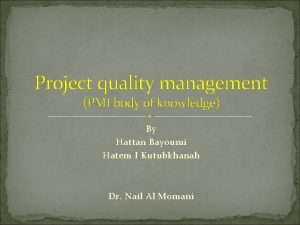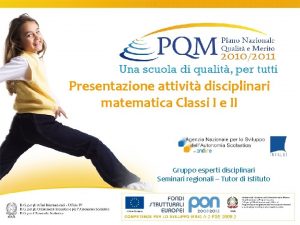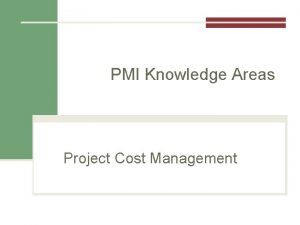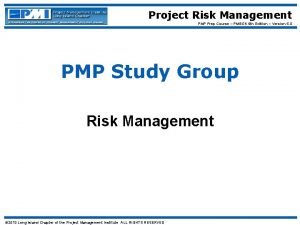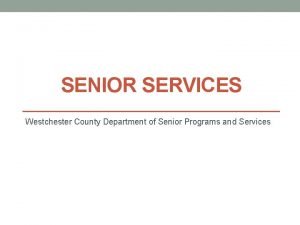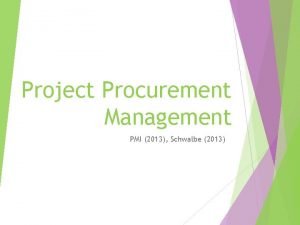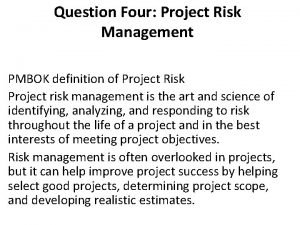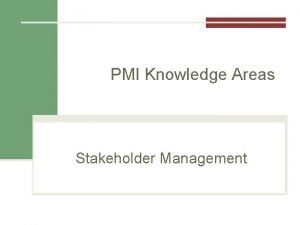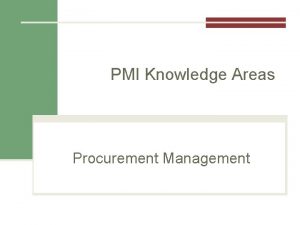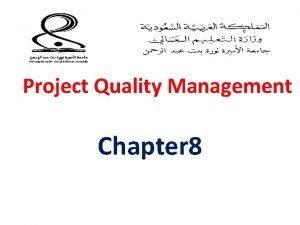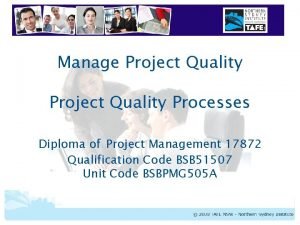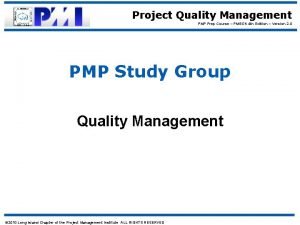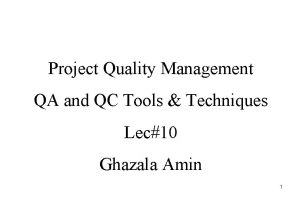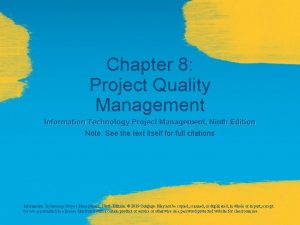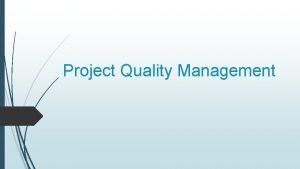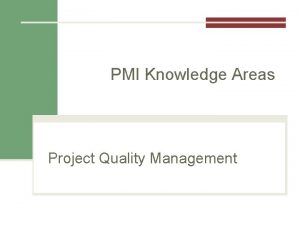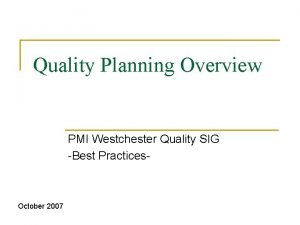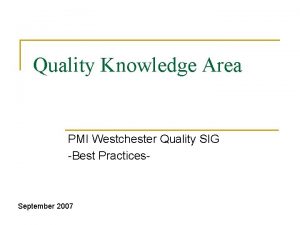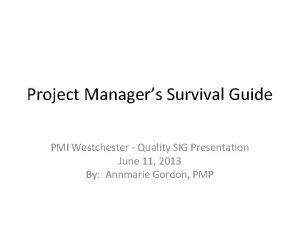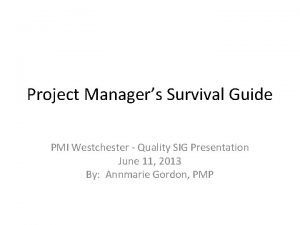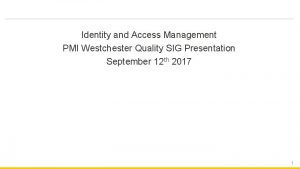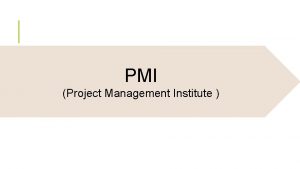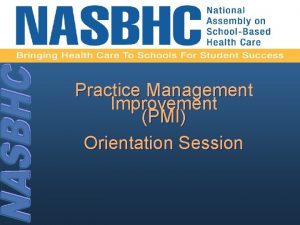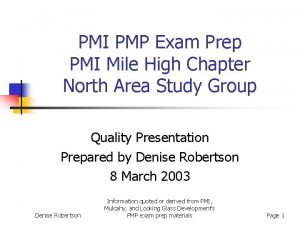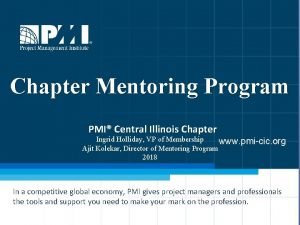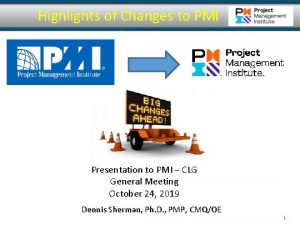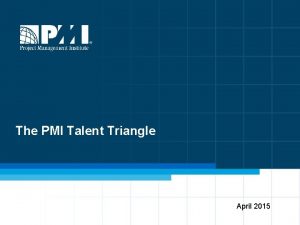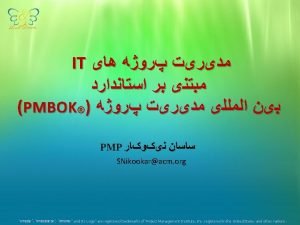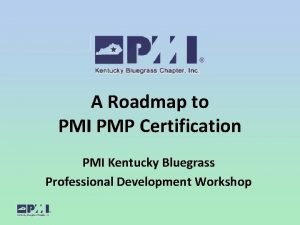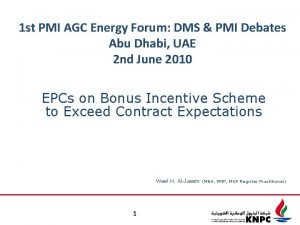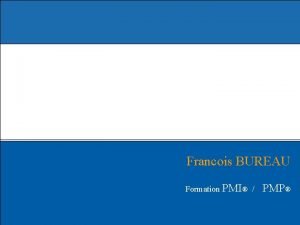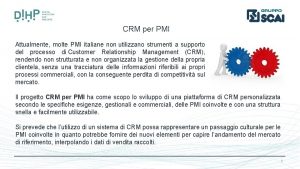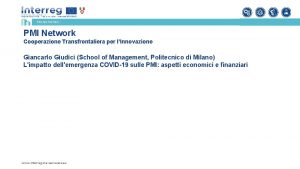PMI Westchester Quality SIG Project Quality Management PQM































- Slides: 31

PMI Westchester – Quality SIG Project Quality Management (PQM) A strategy for improving the quality of IT projects Locksley C. Philips MBA, MISM, CPIM, ITIL (Foundation) March 8, 2011

What we will cover • • Quality and the Triple Constraint Project Quality Management (4 processes) The Quality Plan Criteria for judging quality (2 perspectives) PQM principles improve the quality of IT projects Application of PQM to the Software Testing Cycle Modern Quality Management 2

Quality and the Triple Constraint Quality is in the center of the triangle to show its dependence on all three sides. It cannot exist unless all three sides are balanced. Quality It is the hardest to track and quantify! 3

How Do You Approach Your Project? • Do it right as quickly as possible? . . . tends to discount quality • Do it quickly as right as possible? . . . tends to deliver better quality and faster Often people involved with a project hold the notion that a quality approach will make the project cost more…because of the need for “extra” measurements, audits, and documentation! 4

Managing Project Quality • Quality management is a repetitive cycle of measuring quality, updating processes, and again measuring and updating processes, until the desired quality is achieved. • The goal of quality management is the prevention of defects through the creation of actions that will ensure that the project team understands what is defined as quality. Who is ultimately responsible for quality management on a project? …The Project Manager is. 5

Project Quality Management The main principle of PQM is to ensure that the project will meet or exceed stakeholder’s needs and expectations. – Consists of four main processes: 1. 2. 3. 4. Quality Definition Quality Assurance Quality Control Quality Improvements 6

Quality Definition Process • Expanded PMI definition: “The degree to which a set of inherent characteristics fulfill both stated and implied requirements as defined by the project beneficiaries” • Alternately, it is defined as the “Conformance to requirements, or fitness for use” It is more about preventing and avoiding than measuring and fixing poor quality results 7

Characteristics of Quality • All material or services have characteristics that facilitate the identification of its quality. • Quality characteristics relate to the attributes, measures and methods attached to the particular product or service, and are commonly used to measure the project’s end result. • Characteristics apply equally to material, equipment or service delivered, and to any processes or methods used to deliver them 8

Quality Characteristics of IT Projects • • Functionality – fit for purpose Performance – operates relative to intended use Reliability – performance under normal conditions Features – special characteristics with user appeal System outputs – screens, reports Maintainability – ease of performing maintenance Correctness – program satisfies specifications, fulfils user’s objectives • Efficiency – amounts of computer resources required for software operation 9

Criteria for Judging Quality • From a Business perspective: – Was the project completed on time? – Was the project completed within budget? – Did the system meet my needs when it was delivered? – Is it stable? 10

Criteria for Judging Quality…cont • From a Technical perspective: – Does the system comply with corporate standards for such things as user interface, documentation, naming standards etc. ? – Is the technology stable? – Is the system well engineered so that it is robust and maintainable? 11

Project Quality vs Deliverable Quality • The PM needs to decide how much focus to put on each – Project Quality covers managing changes within the project. – Deliverable Quality covers things like how well it meets the user's needs, and the total cost of ownership. A quality project may deliver low quality deliverables and vice versa. However, it is more likely that a high quality project will deliver high quality deliverables. 12

Quality Assurance Process • The process of periodically auditing overall project performance to ensure the project will satisfy the relevant quality standards, including any legal or regulatory standards • The goal is to reduce the chances that products or services will be of poor quality after the project has been completed. • Occurs during the project’s Implementation Phase, and relies on evidence to create confidence in ongoing compliance to standards. 13

Quality Control Process • The process of monitoring and recording specific project results to ensure that they comply with the relevant quality standards. - Includes how the project performs in its efforts to manage scope, budget and schedule. - Uses techniques and activities to compare actual quality performance with goals and defines appropriate corrective action, as necessary e. g. Cause and Effect Diagram, Pareto Charts, Control Charts, Scatter Diagram 14

Quality Improvements Process • A continuous and systematic process that looks to remove waste, or unnecessary actions to make processes more effective, efficient, and appropriate. – Concentrates on identifying what needs to be improved, analyzing the processes, developing solutions or revisions that will solve the problem, and testing to verify that the new solution is effective. Requires that a baseline be established 15

Quality Improvements…cont • The goal of continuous improvement is to continuously and incrementally improve all aspects of the project, based on lessons learned and new insights provided by the project. To be effective it should happen during all activities of the project. • Requires an organizational culture of reflection that allows the project team to learn from its mistakes, without fear of reprisal, and apply the lessons learned at the next opportunity. 16

The Quality Plan - tying it all together • Every project should have a quality plan, but in reality very few of them do. The plan is a statement of the quality standards that are important to the project. - Plan is developed during the Initiation Phase of the project, and should be a team process - Definition of the end result comes from stakeholders and beneficiaries. 17

The Quality Plan: Overview • All the quality definitions and standards relevant to the project, including legal and regulatory standards. • The conditions that the product or service must possess in order to satisfy the needs and expectations of project stakeholders and beneficiaries. - Situations and conditions which identify what is above or below the quality standard 18

The Quality Plan: Overview…cont • The procedure to ensure that the quality standards are being followed by all project staff. • Steps required to monitor and control quality and the approval process to make changes to the quality standards and the quality plan 19

Quality Plan Details The Project Quality Plan should be written with the objective of providing all project stakeholders with easy access to quality requirements and the ready availability of these standards. • Management Responsibility – Describes the quality responsibilities of all stakeholders • Documented Quality Management System – Refers to the existing Quality Procedures that have been standardized and used within the organization 20

Quality Plan Details…cont • Design Control - Specifies the procedures for Design Review, Sign-Off, Design Changes and Design Waivers of requirements • Document Control – Defines the process to control Project Documents at each phase of the project • Purchasing – Defines Quality Control and Quality Requirements for sub-contracting and part / whole part of the project • Inspection Testing – Details the plans for Acceptance Testing and Integration Testing 21

Quality Plan Details…cont • Nonconformance – Defines the procedures to handle any type of nonconformity. Procedures include defining responsibilities, defining conditions and availability of required documentation in such cases • Corrective Actions – Describes the procedures for taking Corrective Actions for the problems encountered during project execution • Quality Records – Describes the procedures for maintaining the Quality Records (metrics, variance reports, executed checklists, etc) during project execution, as well as after project completion 22

Quality Plan Details…cont • Quality Audits – An internal audit should be planned and implemented during each phase of the project • Training – Should specify any training requirements for the team 23

Checklist for a Basic Quality Plan The Quality Plan for many IT projects only needs to answer a few questions: • What needs to go through a quality check? • When should it be carried out? • How will we monitor our progress? • How will we know if we're on course? • What data do we need, when? • What reports, to whom, when? 24

Using PQM Principles to Improve the Quality of IT Projects • Establish leadership that promotes quality • Foster understanding of the cost of quality – Cost of conformance – Cost of nonconformance • Focus on organizational factors that impact quality (e. g. workspace, lessons learned) • Use a formal lifecycle development process • Use quality focused maturity models • Use appropriate metrics and benchmarking 25

Testing Cycle in Software Development Projects • Types of testing – Unit testing – Integration testing – System testing – User acceptance testing • Testing alone is not enough – Huge number of ways to test a complex system – Requirements for system development are always changing 26

Applying PQM to the Testing Cycle • Quality Planning – Test Strategy, Test Plan • Quality Assurance – define Functional Specifications, Quality Specifications, and Resource Specifications • Quality Control – define Test Specifications, and Test Reporting Requirements 27

Modern Quality Management • Requires customer satisfaction • Favors prevention over inspection • Recognizes management responsibility for quality leadership • Understands that stakeholder’s expectations vary with the organization’s culture, and by geographic region 28

What we covered • • Quality and the Triple Constraint Four processes of Project Quality Management The Quality Plan: elements, judgment criteria PQM principles could be employed to improve the quality of IT projects • Application of PQM to the Software Testing Cycle • Modern Quality Management • Sample documents for takeaway THANK YOU! 29

APPENDIX A Quality Philosophies • Deming Cycle – Plan, Do, Check, Act • Juran Trilogy – Quality Planning, Quality Control, Quality Improvement • Crosby’s Quality Vaccine – Determination, Education, Implementation • Six Sigma • Total Quality Management • ISO 9000 • Maturity Models (CMM, CMMI, SQFD, OPM 3) 30

References 31
 Pmi westchester
Pmi westchester Pim project management certification
Pim project management certification Pmi quality management
Pmi quality management Pqm matematica
Pqm matematica Pmi project cost management
Pmi project cost management Pmbok risk
Pmbok risk Project definition pmi
Project definition pmi Project charter definition pmi
Project charter definition pmi Introduction for project
Introduction for project Heap westchester county
Heap westchester county 2 westchester park drive
2 westchester park drive Pmi 2013
Pmi 2013 Pmbok risk definition
Pmbok risk definition Pmi stakeholder management
Pmi stakeholder management Point of total assumption
Point of total assumption Quality metrics pmp
Quality metrics pmp Project quality management definition
Project quality management definition What are quality standards in project management
What are quality standards in project management Project management lecture notes doc
Project management lecture notes doc Pmbok quality management
Pmbok quality management Quality control tools and techniques
Quality control tools and techniques Project quality management pmp
Project quality management pmp Project management quality control
Project management quality control Project management quality control
Project management quality control Project quality plan
Project quality plan Importance of project quality management
Importance of project quality management The role of project management in achieving project success
The role of project management in achieving project success Modern project profiles in spm
Modern project profiles in spm Project cost duration graph
Project cost duration graph Introduction to project management kathy schwalbe
Introduction to project management kathy schwalbe What is strategic assessment in software project management
What is strategic assessment in software project management When conducting post project audits
When conducting post project audits
